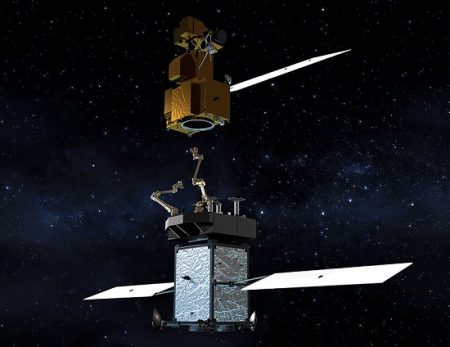July 9, 2017 – I have argued in past postings that the only way our journey to Deep Space will become viable is if we develop a supporting infrastructure. Waystations between Earth and other Solar System destinations are critical to ensuring an effective means by which our species can successfully travel through Deep Space. After all, you wouldn’t begin a long road trip without knowing that there are service stations along the way where you can refuel, or repair your vehiclse should something break.
The dilemma of space travel is the same as the one faced by today’s electric car. Electric cars are limited to only traveling as far as their batteries allow before needing to be recharged. They need to plug in along the way. The lack of a recharging infrastructure is an enormous inhibitor to widespread adoption. spacefarers have to haul with them all of their fuel, oxygen, food, and water. In space we need the equivalent of the truck stop at the side of the highway. At a truck stop, you can buy fuel, eat a meal, shop for things you need, sleep a few hours in a comfortable bed and even take a shower before continuing the journey.
Spacefarers face a similar challenge. Whether robotic or human, a spacecraft has to haul along with it all of the fuel it needs to operate. Bring humans into the equation and you have oxygen, food, and water to add to the mix.
That’s why in space we need the equivalent of the truck stop seen on North American highways. At truck stops, you can get fuel, eat a meal, shop for things you need, sleep a few hours in a comfortable bed, and even take a shower before continuing the journey.
NASA has been thinking about what it will take to build space infrastructure. The experience of the International Space Station has taught NASA’s scientists and engineers about the limitations of current space technology. So the agency has decided to do something about it.
That’s what the planned first Restore-L mission is all about. It is classified as a defined technology demonstration project. The technology on board is considered a test bed for future Deep Space missions including those planned for Mars. The Restore-L is equipped with a number of robotic arms, a propellant transfer system, an autonomous navigation and avionics systems, and sophisticated software to demonstrate space service provisioning capability. It also can be used to de-orbit old satellites or grab and de-orbit thousands of pieces of space junk currently in low-Earth orbit.
Planned launch is mid-2020. As a first test, Restore-L will refuel the United States Geological Survey’s Landsat-7 satellite. Landsat-7 went into orbit in April 1999 and is part of the Landsat program, the longest continuously running space mission devoted to remote sensing and imaging of the Earth. Landsat-7 will eventually run out of maneuvering fuel and with a typical Landsat mission costing as much as $855 million U.S., restoring it to its full functional capability will save hundreds of millions of dollars.
Landsat-7 was joined by Landsat-8 in 2013, and will have an additional companion, Landsat-9, in 2020. Collectively the imagery of all of the current and previous Landsat satellites is proving to be an invaluable resource for those in the fields of agriculture, geology, forestry, archaeology, education, mapping, regional planning, emergency response, and global change studies. The total archive contains more than 7 million images, 2.3 million of them coming from Landsat-7 alone.

The success of the Restore-L mission will be a proof of concept. Future missions will build on what is learned about the requirements for servicing technology infrastructure in space. Eventually, one hopes, a series of similar service satellites will be sent to libration points strung between Earth and Mars, and made accessible for both robotic and human-crewed spacecraft.
NASA has announced it intends to transfer the technology and knowledge derived from the Restore-L 2020 mission to commercial space companies to help jumpstart the space servicing industry.







